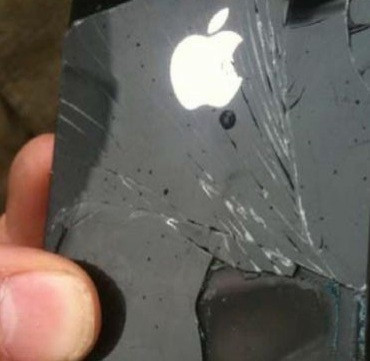iPhone 4 Ignites on an Airplane: Photo Reveals Possible Tampering
ANALYSIS

An Australian regional airline reported Friday that during a Regional Express flight from Lismore to Sydney, a passenger's iPhone began glowing red and venting smoke before a flight attendant doused the device with a fire extinguisher. No one was hurt.
Looking at the photo of the damaged device, however, it appears as though the iPhone was previously tampered with.
Regional Express Holdings provided a photo of the damaged iPhone in its press release, but looking closely, the back of the phone features an Apple icon with the silhouette of Steve Jobs. Apple says it has never released a version of the iPhone with Jobs' silhouette etched onto the icon, for promotions or otherwise.
An Apple fanboy from Hong Kong named Jonathan Mak designed an iPhone for Steve after Jobs died Oct. 5, which was a back panel that one could attach to an iPhone 4 or 4S. The panel came in black or white, and could be bought for a mere $23.90. Mak says the rear panel is exactly of the same dimensions and thickness as the original Apple rear panel, and he also used a glass lens cover and flash diffuser of the same quality as the original from Apple.
Mak's design also included Jobs' name and timeline on the back. The damaged iPhone 4 from the plane featured Jobs' silhouette in the logo, but did not display his name or birth and death dates.
If the passenger bought and installed a customized rear panel, it's possible that the panel didn't align with the phone correctly or exerted extra pressure on the phone's battery. Scott Dingle, an account representative at iFixit, doesn't believe this is the cause of the combustion.
The distance between the back and the battery is pretty significant, so the only plausible thing was the back was so defective or so bent that it wasn't installed properly, Dingle said. Unless it had a huge growth on the back of it... but the possibility of that is very low. I can't imagine a situation where somehow the back was perfectly pressing against the battery. Nothing seems plausible.
Regional Express representatives did not respond to an initial inquiry. The Australian Transport Safety Bureau (ATSB) and the Civil Aviation Safety Authority (CASA) are both on the case.
We do have the phone, it's in our custody, and we will be undertaking a technical examination of it, said an ATSB spokesperson.
CASA spokesperson Peter Gibson said the ATSB would strip the iPhone 4 down sometime this week and try to understand what happened. Fiona Martin, the spokeswoman for Apple Australia, says the company is looking forward to working with officials in investigating the incident.
The ATSB says it has no previous records of iPhones undergoing spontaneous self-ignition, but several such cases have occurred with laptops, smartphones and iPhones.
In 2009, reports came pouring in from Europe detailing horrific explosions of Apple devices. In the Netherlands, an iPhone 3G turned bright red, caught fire and burned a hole through a car seat. In another instance, a French teenager claimed his iPhone cracked up and left a glass shard in his eye. The most similar case to the Regional Express plane incident occurred in Great Britain, where a teenage girl from Liverpool said her iPod Touch exploded after increasing in temperature and hissing violently. The father of the teenage owner said within 30 seconds there was a pop, a big puff of smoke, and [the phone] went 10 feet in the air. The father and daughter left the car as the phone combusted, and returned later to find the car filled with black smoke.
Apple did not admit liability in either case, telling the European Commission it regarded the explosion cases as isolated incidents with no evidence of a general problem. The company did, however, did offer the teenaged Liverpool owner about a $271 refund, with a caveat that she agree that you will keep the terms and existence of this settlement agreement completely confidential. The Cupertino, Calif.-based company also added that a breach of confidentiality may result in Apple seeking injunctive relief, damages and legal costs against the defaulting persons or parties. The Liverpool owner did not sign the agreement, and thus was not compensated for the incident.
The iPhone 4 is made with a built-in rechargeable lithium-ion battery, which is known to overheat. In 2006, Sony recalled its lithium-ion batteries in a move that cost the company $429 million. Two years later, Sony again recalled about 100,000 notebook batteries after learning about overheating issues.
The U.S. House of Representatives passed a rule in April that bars the Obama Administration from limiting shipments of lithium-ion batteries by air. The proposed rule, put together by the FAA and the Pipeline and Hazardous Materials Safety Administration, noted that 21 out of 44 lithium-ion battery incidents occurred on passenger aircraft; 16 involved carry-on luggage, and one occurred in checked baggage. The other 23 incidents occurred on cargo aircraft, presumably where batteries were being shipped in bulk. The rule would have eliminated exceptions for small lithium-ion batteries, classifying all lithium-ion batteries kind as Class 9 hazardous cargo.
Apple's iPhone 4 is still the most popular and best-selling mobile handset in the U.S., followed by the iPhone 3GS, the HTC EVO 4G, the Motorola Droid 3, and Samsung Intensity II rounds out the top five. In the fiscal year ended Sept. 24, Apple sold 72.3 million iPhones.
© Copyright IBTimes 2024. All rights reserved.






















